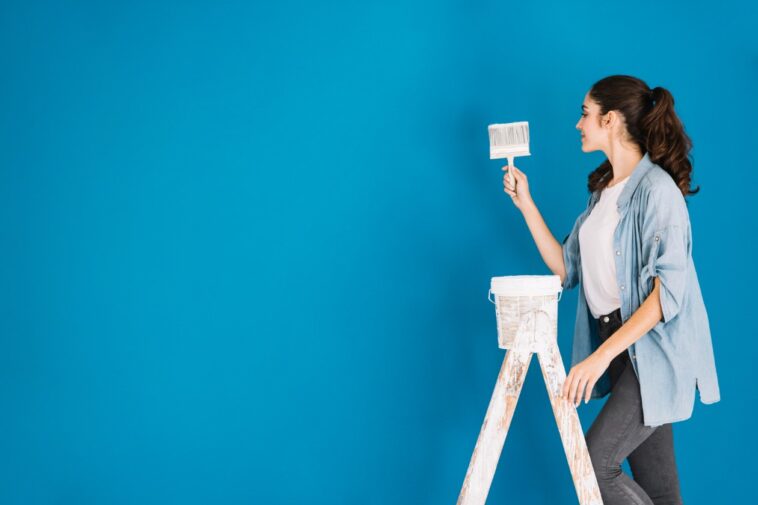If you’ve recently given your home a fresh coat of paint, congratulations! A newly painted wall can instantly transform the look and feel of a room. However, to ensure that your paint job stays vibrant and lasts for years to come, proper care is essential. In this comprehensive guide, we’ll walk you through the step-by-step process of caring for newly painted walls. Whether you’re a seasoned DIY enthusiast or a first-time painter, these tips will help you maintain the beauty of your walls.
Explore the Contents
Gathering Your Supplies
Before you begin the process of caring for your newly painted walls, it’s essential to gather the necessary supplies. Here’s what you’ll need:
- Soft Cloths: These will be used for gentle cleaning and wiping without damaging the paint.
- Bucket of Warm Water: Warm water is effective for cleaning and can be used with mild detergents.
- Mild Dish Soap: A mild dish soap is suitable for cleaning any stains or spills on your painted walls.
- Sponge: A soft sponge is useful for gentle scrubbing and stain removal.
Duster or Microfiber Cloth: This will help you remove dust and cobwebs from your walls without scratching the paint.
Small Paintbrush: Keep a small paintbrush handy for touch-ups, in case your walls get minor nicks or scuffs.
Leftover Paint: Retain the leftover paint from your painting project. It’s essential for matching colors when doing touch-up work.
Understanding the Drying Process
Patience is key when it comes to newly painted walls. Most paints will dry to the touch within a couple of hours, but it can take up to 30 days for the paint to fully cure. During this curing period, avoid touching or scrubbing the walls.
Read More: How to Paint a Teal Bedroom: The Ultimate Guide
Cleaning and Maintaining Painted Walls
Removing Dust and Cobwebs
Regularly dust your walls with a soft cloth or a duster to prevent a buildup of dust and cobwebs. This simple step can keep your walls looking fresh.
Tackling Stains and Spills
Accidents happen. If you spill something on your painted wall, act quickly. Gently blot the stain with a clean, damp cloth and mild dish soap. Avoid scrubbing, as this can damage the paint.
Preventing Wall Damage
Furniture Placement
Be mindful of where you place furniture against your walls. Using felt pads or bumpers between furniture and the wall can prevent unsightly scuffs and marks.
Wall Art and Decorations
When hanging art or decorations, use appropriate hanging hardware. Avoid excessive nail holes, as these can weaken the wall’s integrity.
Touching Up Paint
Over time, your walls may develop small nicks or scuffs. Keep your leftover paint on hand to touch up these areas. Use a small paintbrush and feather the new paint into the existing paint for a seamless finish.
Maintaining the Finish
To maintain the sheen and finish of your painted walls, avoid abrasive cleaners or excessive scrubbing. Stick to mild detergents and gentle cleaning methods.
Dealing with Mold and Mildew
If you notice mold or mildew on your walls, address it promptly. Use a mixture of water and white vinegar to remove these growths. Ensure proper ventilation in humid areas to prevent future issues.
Regular Inspections and Maintenance Schedule
Make it a habit to inspect your painted walls regularly. Catching and addressing issues early can prevent costly repairs later on. Set a maintenance schedule for cleaning and touch-ups.
Understanding the Drying Process
Patience is key when it comes to newly painted walls. Most paints will dry to the touch within a couple of hours, but it can take up to 30 days for the paint to fully cure. During this curing period, avoid touching or scrubbing the walls.
Cleaning and Maintaining Painted Walls
Removing Dust and Cobwebs
Regularly dust your walls with a soft cloth or a duster to prevent a buildup of dust and cobwebs. This simple step can keep your walls looking fresh.
Tackling Stains and Spills
Accidents happen. If you spill something on your painted wall, act quickly. Gently blot the stain with a clean, damp cloth and mild dish soap. Avoid scrubbing, as this can damage the paint.
Preventing Wall Damage
Properly preventing wall damage is essential to maintaining the pristine appearance of your newly painted walls. Here are some tips to help you safeguard your walls from unsightly scuffs and marks:
Furniture Placement
When arranging your furniture, be mindful of how it interacts with your walls. Here’s what you can do:
- Felt Pads: Place felt pads or bumpers on the legs of chairs, tables, and other furniture that may come into contact with the walls. These soft pads create a buffer and reduce the risk of leaving scratches or marks.
- Regularly Check and Adjust: Periodically check the placement of your furniture. Over time, heavy pieces may shift slightly. Adjust them to ensure they don’t lean or press against the walls.
Wall Art and Decorations
Hanging art and decorations can enhance the beauty of your walls, but it’s important to do it correctly:
- Use Appropriate Hardware: Invest in high-quality hanging hardware that is designed for the weight and size of your artwork or decorations. This will prevent items from falling and causing damage to the walls.
- Plan Placement: Before hammering nails or drilling holes, plan the placement of your wall art. Measure and mark where you want to hang items to avoid unnecessary holes in the wrong spots.
By taking these preventive measures, you can significantly reduce the risk of wall damage and maintain the flawless appearance of your painted walls.
Remember that proactive steps like these can go a long way in preserving the beauty of your walls and prolonging the life of your paint job.
Wall Art and Decorations (Continued)
- Use Wall Anchors: For heavy or large wall decorations, consider using wall anchors. Wall anchors provide extra support and stability, ensuring that your artwork remains securely in place.
- Avoid Excessive Nail Holes: Be mindful of the number of holes you make in the walls. Excessive nail holes can weaken the wall’s structure and may require patching and repainting.
- Regularly Check Fastenings: Periodically inspect your wall art and decorations to ensure that they are still securely fastened. Over time, screws or hooks may become loose, so tightening them as needed is essential.
Touching Up Paint
Even with precautions in place, accidents can still happen, and walls may develop small nicks or scuffs over time. Here’s how to effectively touch up the paint:
- Gather Your Supplies: Retrieve the leftover paint from your initial painting project and have a small paintbrush on hand.
- Clean the Area: Before touching up, clean the affected area with a soft cloth to remove any dirt or debris.
- Apply the Paint: Dip the small paintbrush into the paint and carefully fill in the damaged or discolored area. Feather the new paint into the existing paint to ensure a seamless blend.
- Allow to Dry: Let the touched-up area dry completely. The drying time will vary depending on the type of paint used.
By following these steps, you can easily address minor imperfections on your walls and keep them looking flawless.
Maintaining the Finish
To maintain the sheen and finish of your newly painted walls, it’s important to follow some guidelines:
- Use Mild Detergents: When cleaning your walls, opt for mild detergents or cleaning solutions. Harsh chemicals can strip away the paint finish and leave your walls looking dull.
- Gentle Cleaning Methods: Avoid using abrasive scrubbers or harsh scrubbing motions. Instead, use a soft cloth or sponge and apply gentle pressure to remove dirt or stains.
- Frequent Dusting: Regularly dusting your walls with a soft cloth or duster will help prevent the buildup of dust and maintain the paint’s luster.
Taking care of your painted walls with these maintenance practices will not only keep them looking great but also extend the life of your paint job. Proper care ensures that the vibrancy of your walls remains intact for years to come.
Read More: 9 Best Paint Colors for Modern Interiors
Conclusion
Caring for newly painted walls is a simple yet essential part of maintaining the beauty and longevity of your home’s interior. By following the step-by-step guide provided in this article, you can ensure that your freshly painted walls remain vibrant and flawless for years to come.
Remember to gather the necessary supplies, understand the drying process, and follow proper cleaning and maintenance techniques. Preventing wall damage through thoughtful furniture placement and careful handling of wall art and decorations will help preserve the pristine appearance of your walls.
FAQs
Q1: Can I use any type of paint for my walls?
A1: While you have some flexibility in choosing paint, it’s essential to select a paint designed for interior walls for the best results.
Q2: How often should I clean my painted walls?
A2: Dusting can be done weekly, while a more thorough cleaning can be done every few months or as needed.
Q3: Is it necessary to wait for 30 days before touching up paint?
A3: While waiting for the paint to fully cure is ideal, you can touch up minor imperfections sooner if needed.
Q4: What should I do if the paint color has faded over time?
A4: If your paint has faded, consider repainting the affected area with a fresh coat of the same color.
Q5: Can I use a pressure washer to clean painted walls?
A5: It’s not recommended to use a pressure washer, as it can damage the paint. Stick to gentler cleaning methods.



